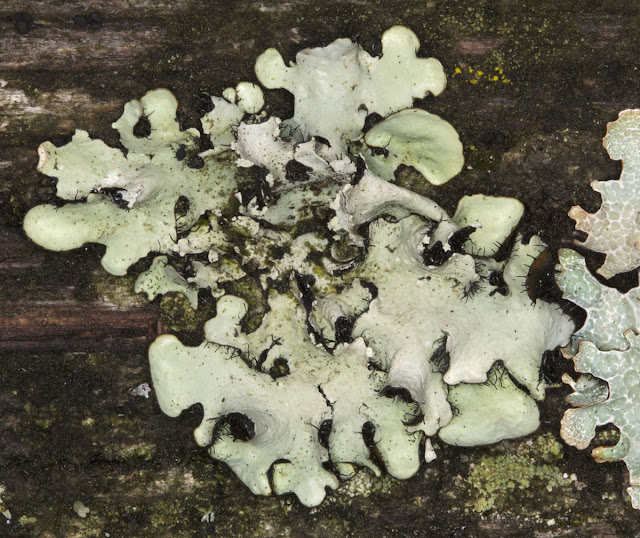 |
| Stereum species. Lullingstone Country Park, 31 December 2011. |
This follows on from the last post, about the Orpington Field Club's trip to Lullingstone Country Park on 31 December. At this point we were in a wood, Upper Beechen Wood, at a high point in the park.
There were quite a few felled treetrunks lying around the path, and many of them had colourful or interesting fungi. The first photo is a small bracket only a few inches across, probably a Stereum species as it had no pores on its underside.
 |
| Oak Mazegill, Daedalea quercina. Lullingstone Country Park, 31 December 2011. |
This one is larger, and grew up to about a foot across. It's called a Mazegill because of the appearance of the underside.
Down the hill, the path back to the visitor centre was separated from a bridleway by a rough wooden railing, on which were many lichens and some mosses.
 |
| A lichen with many black cilia, probably Parmotrema reticulatum. Lullingstone Country Park, 31 December 2011. |
This one puzzled those on the trip, but one of the
iSpot people thinks it looks like Parmotrema reticulatum. You can see that many black hairs or cilia are growing around the edges. This form, with leafy lobes and a distinct underside, is called foliose.
 |
| Ramalina farinacea. Lullingstone Country Park, 31 December 2011. |
This form, with a bushy appearance and no distinct upper or lower side, is called fruticose. You have to be careful with these; some species look like this, but on closer examination turn out to have a distinct underside. They are only pretending to be fruticose.
Finally, a pretty moss with lots of fruiting capsules.
 |
| Cape Thread-moss, Orthodontium lineare. Lullingstone Country Park, 31 December 2011. |
This identification is conditional. If, when it dries up, the "leaves" curl and twist, it will be something else entirely, not deserving of a name which says it has straight teeth.





No comments:
Post a Comment